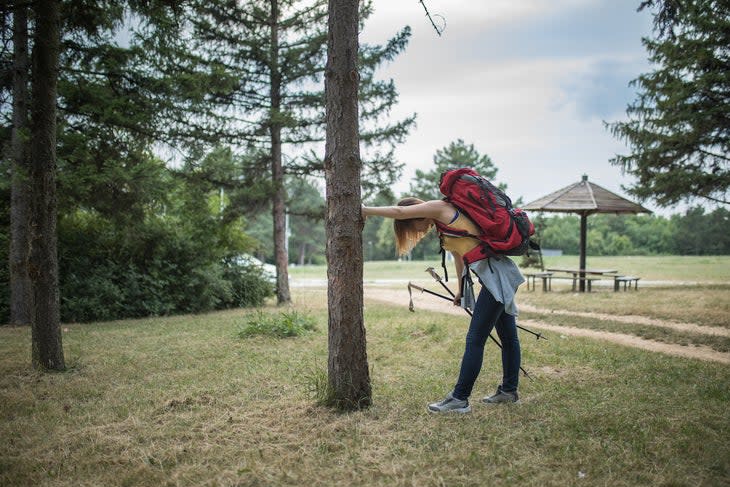Turning Back Early Doesn’t Make You a Quitter. In Fact, It Could Save Your Life.
This article originally appeared on Backpacker
I've done a couple dumb (read: dangerous) things in the name of hiking. I’ve limped to the tops of peaks on torn calf muscles. I once pretended not to hear thunder nearby because we were so close to the viewpoint. I'll never forget when I hiked 7 miles through altitude sickness-induced nausea, too timid to tell my group that I was seconds from losing my MacroBar. Each time, one thing clouded my judgment: a fixation on achieving my goal despite all odds. In hindsight, no longer goal-blind, I can see when I've put myself in danger, and I've learned that there are many circumstances in which it's safer to turn around or wait for better conditions.
Summit Fever
Symptoms: A want-turned-need to make it to the top of the mountain, through the storm, up a too-technical trail, just one more mile, despite any hazards you encounter.
At-risk: Goal-focused adventurers of all skill and experience levels.
Treatment: Listen to your body and learn to read your surroundings.
Many search and rescue scenarios begin when hikers ignore signs telling them to turn back, says John Becker, the vice president of Atalaya Search and Rescue in Santa Fe, New Mexico. These hikers get summit fever--a parasitic mindset that anything other than their exact goal is a failure. But you can't put your blinders on as soon as you get to the trail. There are objective hazards when you're in the backcountry, and summit fever can distort their severity and significance.
If you're susceptible to summit fever, temper your expectations ahead of time. Before you see the trail and the eagerness takes over, make a mental game plan. What are the consequences of pursuing through spontaneous hazards? Are there any checkpoints you or your group will use to assess how the hike is going?

Toxic Motivation
It's one thing to be tenacious and motivated, but it's another to be dangerously stupid. Toxic motivation is the mental block where your goals overtake your sensibility, and you stop at nothing to achieve them. With this state of mind, you can easily end up in a dangerous situation. This is the essence of "summit fever" and has led to numerous accidents and fatalities, Becker says. There are two kinds of toxic motivation: internal and external. You need calm, honest self-awareness to combat both.
Internal Toxic Motivation
Backpackers and hikers are determined by nature, and we can be perfectionists; we tend to get disappointed or angry if we don’t reach the peak, so we push beyond our limits. Check your internal monologue. Are you being honest with yourself and your surroundings, or letting this goal dictate the day? There are no failures in hiking; if you don't reach your goal, you can always try it again next time.
"Putting your ego in its place can be hard to do if a lot of your identity is tied up with getting it done, but that’s what you need to do," Becker says.
External Toxic Motivation
In a hiking group, you're balancing how you're feeling with your group's values and collective decisions. It's easier to suffer in silence instead of standing out as the "quitter" who suggested turning around first, but, as Becker says, if you're feeling unsure about something, someone else in your group probably is too. The best way to rise above this kind pressure is finding the courage to speak out if your gut is telling you that something's off.
A good hiking group is one that makes sure that everybody is comfortable, heard, and reasonably challenged. If the thought of voicing any concerns to your group sends shivers down your spine, your group is toxic in more ways than its motivation.
"Make sure your group has a rule that we always use in search and rescue: Any one person can call a stop at any time if they think the situation is unsafe," Becker says. "At the least, the group can reappraise the situation, which might lead to an appropriate change in plans."

Common Hazards To Take Seriously
There's no shame in bailing early. The trail will still be there tomorrow, next season, or next time you're in the area. Your goal is to make sure that you’re still there too. Check in periodically with yourself, your hiking group, and your environment to see if you're in a situation to continue or turn back.
Weather
Mackerel skies--rippled rows of cirrocumulus or altocumulus clouds that look like fish scales--can indicate an incoming weather change. (You can't deny the saying, "Mackerel sky, mackerel sky, never long wet, never long dry.") Pretending that you don't see those clouds, hear that thunder, or smell that smoke doesn't only put your own life at risk, but it also endangers the lives of those who would have to rescue you.
"Being on a ridgetop, peak, or any open area substantially increases your risk of a lightning injury," Becker says. "Risk of hypothermia is also a consideration year-round in the mountains. If you aren’t prepared to cope with sleet or snow in the forecast, you should think twice about proceeding. Summit fever might make you ignore advancing clouds or other clues that the weather is changing."
Natural Disasters
Last month's McKinney Fire tested a lot of Pacific Crest Trail thru-hikers' ability to practice common sense and adapt. Lize "Indy" de Klerk had to evacuate because she was too close to the fire. She and her tramily backtracked to Etna, California, to wait out the smoke for a couple nights.
"We had been seeing a lot of smoke and then we got word that there was an 18,000 acre fire somewhere north of us and that it was zero percent contained," she says. "There is no way you can outrun a wildfire or compete with any kind of the elements. Without cell signal or anything you really have to trust your instincts out there and err on the side of safety, which is why we decided to turn around. In hindsight it was the best decision we could have made."
Unrealistic Fitness
Maybe you recently got Covid and your lungs haven't quite returned to normal. Maybe you're coming back from an injury or this trail has way more vert or scrambling than what you trained for. Or you had one too many margaritas the night before or you couldn't get enough sleep. There are a lot of reasons why a hike might feel more challenging than you expected, and pushing past your ability just to bag a peak can be unrealistic or dangerous. It's healthier to hike with a motivation based in kindness and self-respect, instead of one based on all-or-nothing perfection. Think about what kinds of actions will best serve you physically and mentally in the long term. An injury you pushed through to achieve a short-sighted goal can get worse and set your recovery back even farther. But, meeting your body where it's at on that current day, and hiking realistically based on how you're feeling, is the best for your physical and mental health.
For exclusive access to all of our fitness, gear, adventure, and travel stories, plus discounts on trips, events, and gear, sign up for Outside+ today.

